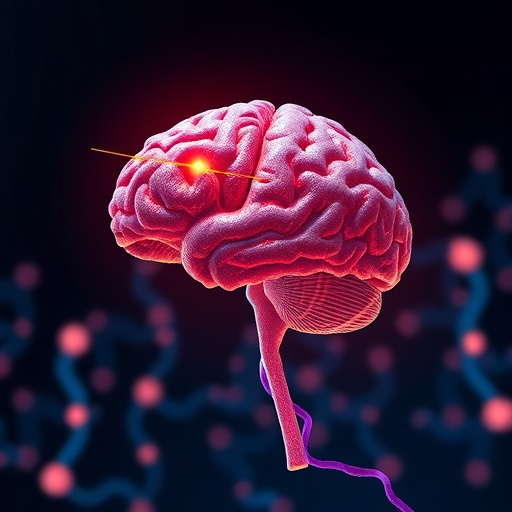A groundbreaking study led by researchers at the University of California, San Diego, has established a revolutionary understanding of Alzheimer’s disease by illustrating how a gene previously recognized merely as a biomarker is, in fact, a key causative factor of the illness. The gene in focus, phosphoglycerate dehydrogenase (PHGDH), has revealed a complex relationship with Alzheimer’s that transcends its initially understood role in metabolic processes. Through advanced utilization of artificial intelligence, this innovative research provides not only insights into the fundamental mechanisms underlying spontaneous Alzheimer’s but also a potential pathway for therapeutic intervention.
Alzheimer’s disease remains the most prevalent form of dementia, affecting approximately one in nine individuals aged 65 and older. Understanding the driving forces behind the disease has been challenging, particularly due to the limited connection observed with known genetic mutations. While some patients exhibit variations in specific genes linked to Alzheimer’s, a significant majority suffer from what researchers term “spontaneous” Alzheimer’s. The mechanisms leading to this variant of the disease remain largely elusive, and this new research sheds light on possible underlying causes.
The team, led by Sheng Zhong, focused initially on the metabolic functions of PHGDH. In previous studies, they had discovered that increasing levels of this gene correlated with disease severity in Alzheimer’s patients, suggesting a potential connection between PHGDH expression levels and Alzheimer’s progression. However, the link remained nonspecific until the researchers sought to establish whether the gene plays a direct causal role in disease development. Their findings, derived from experiments conducted on both murine models and human brain organoids, indicate that fluctuations in PHGDH expression lead to significant alterations in Alzheimer’s disease progression.
Lowering PHGDH expression levels was shown to hinder disease advancement, while increasing these levels resulted in greater disease severity. This pivotal discovery indicates that PHGDH is not just a genetic marker but a facilitator of early Alzheimer’s pathology through a mechanism previously unrecognized by the scientific community. Through AI-driven analysis, the research team revealed that PHGDH also plays a critical role in modulating transcriptional regulation, thereby affecting how genes are activated in the brain cells of Alzheimer’s patients.
Preliminary testing of NCT-503 in relevant mouse models of Alzheimer’s showed promising results, characterized by improved cognitive functions and reduced anxiety levels—common symptoms faced by Alzheimer’s patients. The results underscore the molecule’s potential as a candidate for further clinical development, emphasizing the need for continued studies to refine and optimize such compounds for human application.
Despite emerging challenges, such as the limitations in existing animal models that do not perfectly simulate spontaneous Alzheimer’s, the study brings a hopeful outlook on future Alzheimer’s research. The promise of developing small, orally available molecules contrasts sharply with more traditional infusion-based treatments, potentially easing the administration process for patients.
Importantly, the research not only contributes to the scientific understanding of Alzheimer’s disease but positions PHGDH as a focal point for novel therapeutic interventions. This exciting discovery heralds a new chapter in Alzheimer’s research, particularly highlighting the value of interdisciplinary approaches blending artificial intelligence with molecular biology to unlock the complex mechanisms of disease.
As advancements continue, the following steps involve honing the efficiency of NCT-503 and ensuring its efficacy through FDA IND-enabling studies. The study signifies the potential for new classes of therapeutic agents aimed at correcting molecular imbalances in Alzheimer’s, offering hope where treatment options are currently sparse.
In conclusion, the work undertaken by this research team exemplifies the convergence of cutting-edge techniques that are revealing new layers of complexity in the fight against Alzheimer’s disease. With further refinement of PHGDH-related therapies and detailed investigations into their mechanisms of action, the future trajectory for Alzheimer’s treatment may become significantly more effective. As we await the outcomes of ongoing studies, this breakthrough research paves the way for a deeper understanding and potentially, a transformative impact on how this devastating disease is managed in the years to come.
Subject of Research: Alzheimer’s Disease and the role of PHGDH
Article Title: Transcriptional regulation by PHGDH drives amyloid pathology in Alzheimer’s disease
News Publication Date: 23-Apr-2025
Web References: https://doi.org/10.1016/j.cell.2025.03.045
References: Not applicable
Image Credits: Not applicable
Keywords
Alzheimer’s disease, PHGDH, biomarker, artificial intelligence, gene regulation, treatment, cognitive decline, transcription factors, amyloid plaques, mouse models, small molecules.
Tags: advanced AI in healthcareAlzheimer’s disease researchartificial intelligence in medical researchchallenges in Alzheimer’s researchgenetic factors in dementiainsights into Alzheimer’s treatmentmetabolic processes and Alzheimer’sphosphoglycerate dehydrogenase role in Alzheimer’sspontaneous Alzheimer’s mechanismstherapeutic candidates for Alzheimer’sUC San Diego Alzheimer’s studyunderstanding dementia causes





